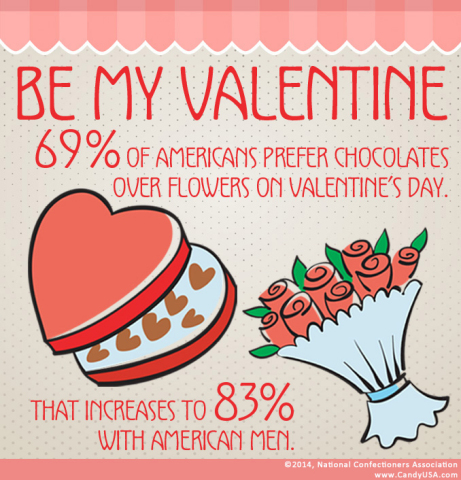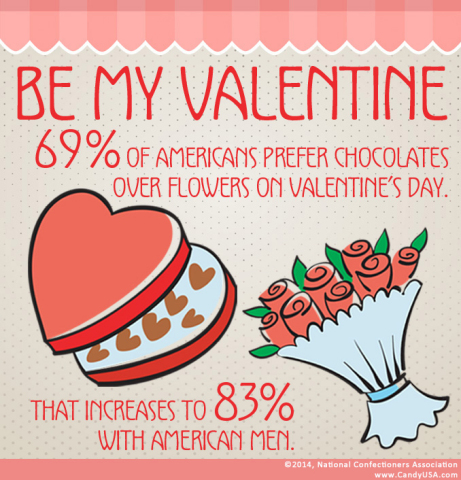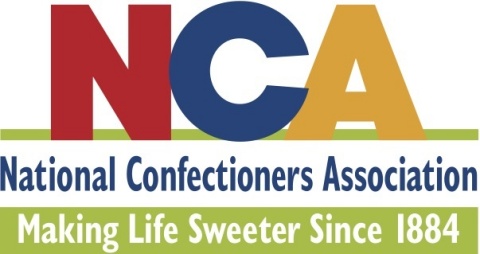WASHINGTON--(BUSINESS WIRE)--Valentine’s Day gift-givers, take note: Americans overwhelmingly prefer chocolate instead of flowers (69 vs. 31 percent) on Valentine’s Day, according to a nationwide survey by the National Confectioners Association (NCA). Women are a little divided on the matter, however, with 59 percent preferring chocolate compared to 83 percent of men.
The survey of more than 1,300 adult consumers also suggests that Cupid struck Americans with a love for caramel – it’s the most popular flavor in a box of Valentine’s Day chocolates with 34 percent of the responses. Chocolate-covered nuts also scored high (24 percent), with cream-filled (13 percent) and chocolate-filled (13 percent) rounding out the pack of top choices.
Total U.S. confectionery sales for Valentine’s Day 2014 are projected to be $1.057 billion, a 1.9 percent increase over 2013. Chocolate makes up around 75 percent of candy sales at Valentine’s Day.
“Americans have a longstanding tradition of sharing candy with family, friends and colleagues during the holidays,” said NCA Vice President of Communications Susan Whiteside. “Valentine’s Day is no exception, with 83 percent of respondents citing the February holiday as a top candy-sharing occasion. There’s no question that sweet treats have a special place in everyone’s heart this holiday season.”
Valentine’s Day Purchasing Trends
NCA’s survey found purchasing habits have changed slightly compared to five years ago, particularly regarding health-related decisions. Twenty-eight percent of respondents said they are buying more healthy options, such as dark chocolate or chocolate with added nuts and fruit. Roughly 20 percent are buying more portion-sized seasonal chocolate and candy. Other results include:
- Price check. Twenty-two percent of Americans are buying more of what’s on sale.
- Upping the ante for your loved ones. About 16 percent are buying more high-end or specialty seasonal products and packages.
Additional purchasing trends for 2014 point to the critical role that personal preferences, packaging and presentation play in consumer choices:
- Like dating, first impressions count. Nearly 65 percent believe holiday candy should feature seasonal packaging and colors, such as red and pink for Valentine’s Day. The other roughly 35 percent feels it’s unnecessary to create special holiday packaging.
- To thine own self be true. Personal preferences carry the most influence when purchasing a particular kind of seasonal candy – with price and family preferences following behind.
- Kids: try asking Dad. While almost 76 percent of female respondents say children have no influence on their seasonal candy purchases, only about 46 percent of males feel the same.
Keeping Health & Wellness Top of Mind
Respondents also shared how they enjoy the mental benefits of Cupid’s favorite holiday and practice moderation.
- Spread happiness. Nearly 62 percent agree that celebrating holidays like Valentine’s Day brings happiness in tough economic times.
- Indulge! About 74 percent of those surveyed agree eating healthfully can include the enjoyment of seasonal candy.
- Trying to teach your kids a lesson in moderation this Valentine’s Day? A large share of American parents will do it by giving a certain number of pieces per day until it runs out (41 percent).
Candy-Related February Holidays
Looking to extend your love for candy and those close to you beyond Valentine’s Day? Consider these lesser known February holidays:
- February 15: National Gum Drop Day
- February 16: National Almond Day – U.S. confectioners use about 75 million pounds of almonds and other nuts each year
- February 19: Chocolate Mint Day
- February 26: National Pistachio Day – try chocolate-covered pistachios
See www.CandyUSA.com/VDay for more sweet information on candy, Valentine’s Day, and celebration ideas – including how to tell what filling is in the middle of your chocolates. You can also follow NCA on Twitter (@CandyUSA) and Facebook (www.facebook.com/NationalConfectionersAssociation).
About the National Confectioners Association (NCA): The National Confectioners Association fosters industry growth by advancing the interests of the confectionery industry and its customers. Serving as the voice of the industry, the Association advocates for the needs of the industry before government bodies, helps the industry understand and implement food safety and other regulations, provides information to help members strengthen their business in today’s competitive environment and creates relationships between all sectors of the industry including manufacturers, brokers, trade customers, suppliers to the industry and our consumers.




